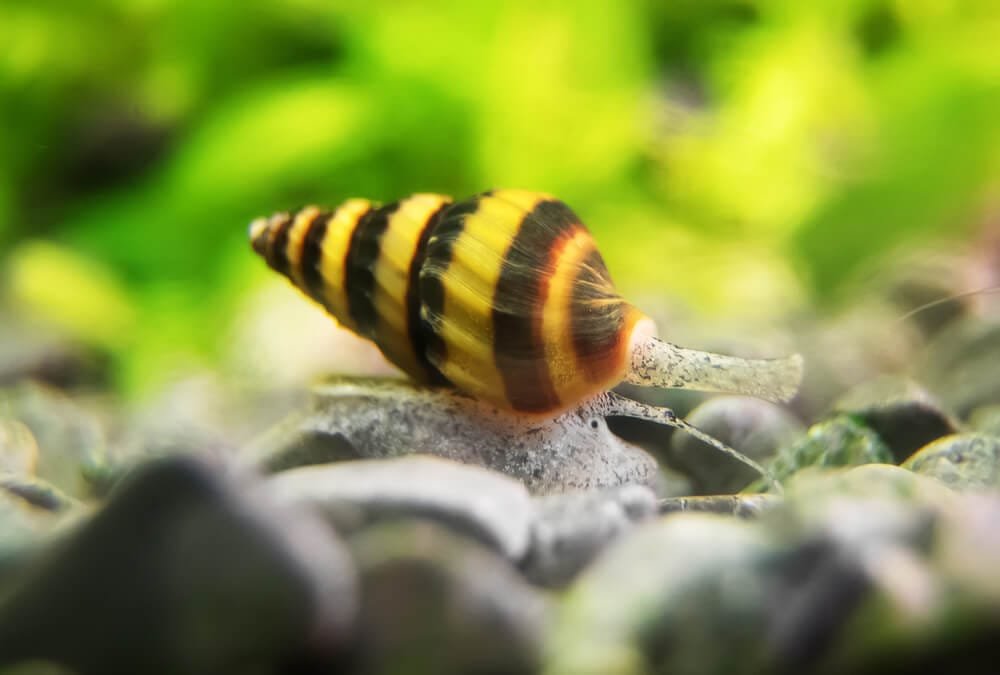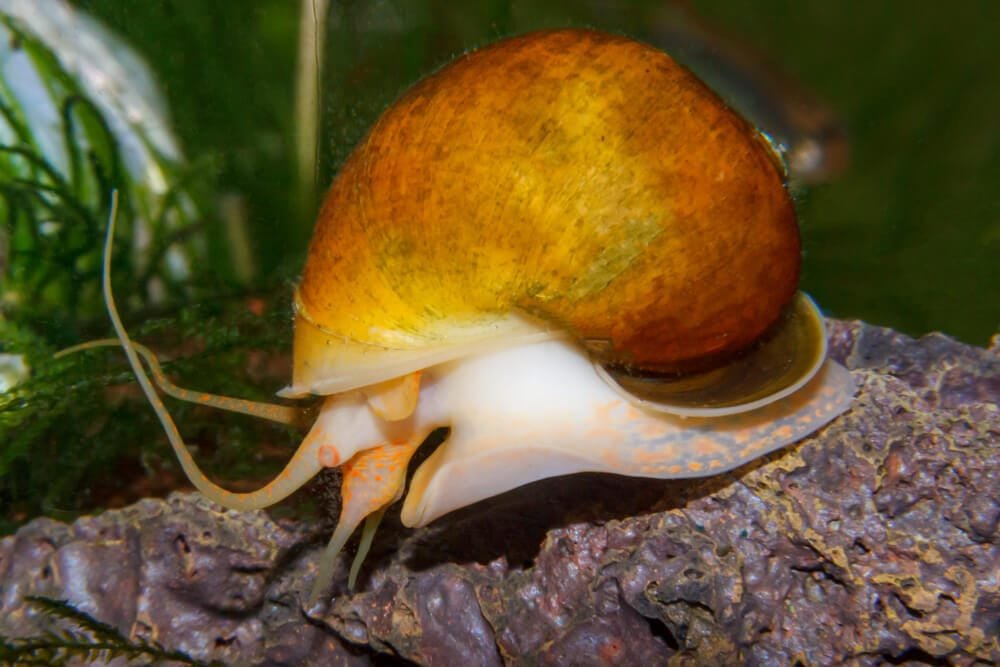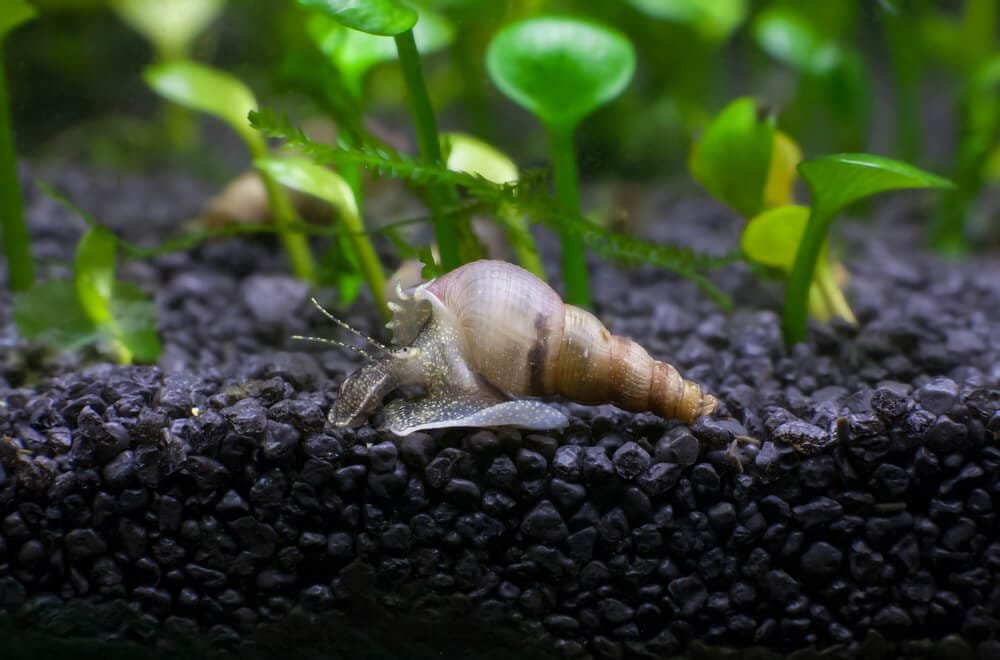Imagine a remarkable creature lurking at the bottom of your fish tank, silently hunting down its prey with unmatched precision and stealth. Known as the Assassin Snail, this tiny marine marvel has gained popularity among aquarists as a natural solution to the problem of snail overpopulation. With its distinctive pattern of yellow and black stripes adorning its spiral-shaped shell, the Assassin Snail certainly lives up to its name, offering an intriguing addition to any aquatic ecosystem. Prepare to be captivated by the charm and prowess of this extraordinary underwater assassin.
Appearance
The Assassin Snail, also known as Clea helena, is a small but fascinating creature that can add a touch of intrigue to any aquarium. These snails have a distinct appearance with a long, cone-shaped shell that is light brown or yellowish in color. The shell is often covered in intricate patterns, which adds to their allure. Despite their small size, Assassin Snails can be quite eye-catching with their unique physical characteristics.
Coloration
The coloration of Assassin Snails can vary, but most commonly they have a light brown or yellowish shell. The shell is often adorned with dark brown or black spiral patterns, creating a visually striking appearance. The body of these snails is usually a shade of grey or dark brown, allowing them to blend in with their surroundings. Overall, their coloration helps them to stay camouflaged and hidden, making them even more intriguing to observe.
Habitat
Native range
Assassin Snails are native to Southeast Asia, specifically regions such as Thailand, Malaysia, and Indonesia. In the wild, they can be found in freshwater environments such as rivers, streams, and ponds. These snails prefer areas with sandy or muddy bottoms where they can burrow themselves. The natural habitats of Assassin Snails are often rich in vegetation and offer ample hiding spots.
Aquarium suitability
Assassin Snails are well-suited for aquariums and are highly sought after by hobbyists. They are relatively easy to care for and can thrive in a wide range of tank setups. These snails are compatible with various water parameters and can adapt well to different conditions. They are also peaceful creatures that can coexist with many other species, making them an excellent addition to community tanks.
Behavior
Feeding habits
Assassin Snails are carnivorous creatures with a unique feeding habit that sets them apart from other snail species. As their name suggests, they are skilled hunters that prey upon other snails, including pest species like Malaysian Trumpet Snails and Pond Snails. They use their long proboscis to locate and immobilize their prey before devouring them. This feeding behavior makes them an effective natural control method for snail population management in aquariums.
Reproduction
Assassin Snails are live-bearers, meaning they give birth to live young instead of laying eggs. When a female Assassin Snail is ready to reproduce, she will lay small, jelly-like capsules containing several baby snails. These capsules are often attached to plants, rocks, or other surfaces in the aquarium. After a gestation period of about 4-6 weeks, the baby snails will hatch and begin their independent lives.
Aggressiveness
Although Assassin Snails are predators, they are generally not aggressive towards other tank inhabitants. They are more focused on hunting and eliminating other snails rather than bothering other fish or invertebrates. However, it is important to note that they may occasionally engage in territorial disputes with other Assassin Snails, especially if overcrowding occurs. Providing ample hiding spots and adequate space can help minimize any potential aggressiveness.
Maintenance
Tank requirements
Assassin Snails have relatively simple tank requirements, making them a suitable choice for both beginner and experienced aquarists. A tank size of at least 10 gallons (38 liters) is recommended to provide enough space for a small group of these snails. It is important to include plenty of hiding spots, such as caves, plants, and driftwood, to mimic their natural habitat. A sandy or muddy substrate is also beneficial, as it allows the snails to burrow.
Water parameters
Assassin Snails are adaptable when it comes to water parameters, but maintaining stable conditions is crucial for their well-being. The temperature should ideally be kept between 72-82°F (22-28°C), with a pH level ranging from 7.0 to 8.0. A moderate water flow is recommended, as excessive turbulence can inhibit their hunting behavior. Regular water changes and the use of a good filtration system are essential for maintaining optimal water quality.
Compatibility with other species
One of the standout traits of Assassin Snails is their compatibility with a wide range of other species. They can coexist peacefully with most community fish, such as tetras, gouramis, and rasboras. Their hunting behavior is primarily focused on other snails, so the risk of aggression towards other fish or invertebrates is minimal. However, caution should be exercised when keeping them with small or slow-moving shrimp, as they may occasionally prey upon them.
Benefits in Aquariums
Controlling snail population
One of the most significant benefits of having Assassin Snails in an aquarium is their remarkable ability to control snail populations. Pest snails like Malaysian Trumpet Snails and Pond Snails can reproduce rapidly and become a nuisance in many tanks. The introduction of Assassin Snails can help keep these populations in check by actively hunting down and consuming the pest snails. This natural method of pest control can help maintain a balanced and healthy ecosystem within the aquarium.
Algae control
In addition to controlling snail populations, Assassin Snails can also assist in algae control. While they primarily rely on snails as their food source, they will occasionally consume small amounts of algae as well. This gentle grazing behavior can help to prevent excessive algae growth and keep the tank looking clean and visually pleasing. However, it is important to note that Assassin Snails alone may not be sufficient for complete algae control, and proper aquarium maintenance practices should still be followed.
Potential Drawbacks
Predatory behavior
While the predatory behavior of Assassin Snails can be beneficial for snail population control, it can also become a potential drawback depending on the aquarium setup. If there are other desired snail species in the tank, they may fall victim to the hunting instincts of Assassin Snails. Additionally, if the population of Assassin Snails becomes too high, they may compete for resources and potentially harm other tank inhabitants.
Nocturnal activity
Assassin Snails are primarily nocturnal creatures, meaning they are most active during the night and tend to be less active during the day. This can make them less visible to aquarium keepers who may prefer to observe their tank during daylight hours. However, with some strategically placed lighting or by observing the tank during dimmer hours, their nocturnal behavior can still be appreciated.
Compatibility issues
While Assassin Snails are generally compatible with a wide range of species, there may be exceptions and compatibility issues to consider. Some fish or invertebrate species may perceive Assassin Snails as a food source or show aggression towards them. It is important to research the specific species in your aquarium and their potential interactions with Assassin Snails before introducing them to ensure a harmonious coexistence.
Breeding Assassin Snails
Tank and water conditions
Breeding Assassin Snails can be an exciting endeavor for aquarists who wish to observe the complete life cycle of these fascinating creatures. The key to successful breeding lies in providing suitable tank and water conditions. A separate breeding tank with similar parameters to the main tank is recommended. Providing ample hiding places like plants, rocks, and caves is important, as it allows the adult snails to deposit their eggs and the young snails to find shelter.
Egg deposition
Female Assassin Snails will lay small, jelly-like capsules called egg cases containing multiple baby snails. These egg cases are often attached to surfaces such as plants, rocks, or the walls of the aquarium. The female will deposit the eggs in hidden areas to protect them from potential predators. The number of eggs in each case can vary but can range from a few to dozens, depending on the individual snail.
Hatching
After a gestation period of about 4-6 weeks, the baby Assassin Snails will hatch from the egg cases. They are born as fully formed miniature versions of the adults and will immediately start looking for food. It is crucial to provide suitable hiding spots and a food source for the young snails to ensure their survival. Gradually increasing their tank mates’ size and providing an appropriate diet will promote healthy growth and development.
Diet
Food preferences
Assassin Snails are primarily carnivorous and have a strong preference for snails. They will actively hunt down and consume pest snails and smaller species. While snails make up the majority of their diet, they will occasionally feed on small crustaceans, such as dwarf shrimp, and consume small amounts of algae as well. It is important to ensure a steady supply of snails or other suitable prey to maintain the health and appetite of Assassin Snails.
Supplementary feeding
In addition to hunting snails, Assassin Snails can be supplemented with a variety of other foods to provide a balanced diet. High-quality sinking pellets or tablets specifically designed for carnivorous invertebrates can be offered as a staple food source. Additionally, occasional feedings of frozen or live foods like bloodworms, brine shrimp, and daphnia can be beneficial to their overall health and promote natural hunting behaviors.
Health and Disease
Common diseases
Assassin Snails are generally hardy and relatively resistant to diseases. However, they are not completely immune and can be susceptible to certain ailments. The most common health issues that may affect Assassin Snails include shell damage or erosion, which can occur due to poor water quality or aggressive tank mates. Furthermore, they can be affected by common aquarium diseases such as parasites or bacterial infections if their tank conditions are not properly maintained.
Preventative measures
To keep Assassin Snails in optimal health and prevent diseases, it is crucial to maintain good water quality. Regular water changes, proper filtration, and monitoring of water parameters such as temperature and pH are essential. Providing a varied and nutritious diet, suitable tank mates, and adequate hiding spots will also help promote their overall well-being. Observing and addressing any signs of disease or shell damage promptly can prevent further complications and ensure the long-term health of Assassin Snails.
Conclusion
Assassin Snails are captivating creatures that can bring both beauty and practicality to an aquarium. With their unique appearance, hunting behavior, and remarkable ability to control snail populations, they offer a multitude of benefits. From their compatibility with various species to their relatively low maintenance requirements, Assassin Snails are an excellent choice for aquarists of all skill levels. By providing them with suitable tank conditions and nourishing their natural instincts, you can enjoy the fascinating presence of these snails while maintaining a healthy and thriving aquarium ecosystem.






